Well Test Analysis of Inclined Wells in the Low-Permeability Composite Gas Reservoir Considering the Non-Darcy Flow
Abstract
:1. Introduction
2. Well Test Model Establishment and Solution
2.1. Physical Model
- (1)
- The gas reservoir has an impermeable top and bottom. re represents gas reservoir radius. h represents Stratum thickness;
- (2)
- The reservoir is divided into an internal zone and external zone. r1 represents internal zone. mi represents the simulated initial formation pressure;
- (3)
- The inclined wells penetrate the entire gas reservoir. θ represents well angle. L represents well length. qsc represents constant ground production.
- (4)
- There is not an extra pressure drop or isothermal flow at the interface of the internal and external zone. The fluid is a single-phase micro-compressible fluid, ignoring gravity and capillary force.
- (5)
- Considering the anisotropy of the well bore storage coefficient, skin factor and permeability. Knhi represents the initial horizontal permeability of the gas reservoir. Knvi represents vertical initial permeability (n = 1,2, where 1 represents the internal zone, 2 represents the external zone, h represents the horizontal direction, and v represents the vertical direction);
- (6)
- The fluid conforms to Darcy’s law in the internal zone. The fluid considers non-Darcy flow and reservoir stress sensitivity in the external zone.
2.2. Equation of Motion
2.3. Mathematical Model
2.3.1. Model Building
2.3.2. Model Solving
3. Analysis of Flow Law
3.1. Comparison of Flow Patterns
3.2. Sensitivity Analysis
3.2.1. Non-Linear Parameters
3.2.2. Well Angle
3.2.3. Internal Zone Radius
3.2.4. Internal and External Zone Pressure Coefficient Ratio
4. Application Case Analysis
5. Conclusions
- (1)
- Based on the microscopic mechanism of non-Darcy flow and stress sensitivity in low-permeability gas reservoirs, the flow motion equation was improved, and a non-Darcy flow mathematical model was established in low-permeability composite gas reservoir inclined wells. This was carried out using the equivalent pressure point to deal with the inner boundary conditions, and the finite element method to solve the bottom hole pressure.
- (2)
- In this paper, the bottom hole pressure dynamic curves of different models are drawn and compared. According to the curve characteristics, seven flow stages are divided, which are as follows: well bore reservoir, excessive skin effect, well inclination angle control, pseudo-radial flow in inner zone, excessive pseudo-radial flow in internal and external zone, pseudo-radial flow in external zone and boundary influence stage.
- (3)
- When the nonlinear factor increases, the pseudo-pressure dynamic curve increases upward in the pseudo-radial flow stage in the external region. When the well inclination is greater than 60°, the early vertical radial flow section gradually appears, and the duration is prolonged with the increase of the well inclination. The radius of the internal zone increases, and the duration of the quasi-radial flow phase in the internal zone is prolonged. When the pressure coefficient ratio of the internal and external zones is greater than 1.0, the slope of the transition section is positive and increases with the increase in the pressure conductivity ratio.
- (4)
- Compared with the traditional well test model, the low-permeability composite gas reservoir non-Darcy flow model fits better with the pressure dynamic curve. The main reason is to increase the constraints on the interpretation results, such as nonlinear factors, and reduce the multi-solution of the parameters. The permeability explained by the two models is significantly different, and the non-Darcy flow model reasonably evaluates low-permeability gas reservoir productivity.
Author Contributions
Funding
Institutional Review Board Statement
Informed Consent Statement
Data Availability Statement
Conflicts of Interest
References
- Wei, X.; Qun, L.; Shusheng, G.; Zhiming, H.; Hui, X. Pseudo threshold pressure gradient to flow for low per- meability reservoirs. Pet. Explor. Dev. 2009, 36, 232–236. [Google Scholar] [CrossRef]
- Li, D.; Zha, W.; Liu, S.; Wang, L.; Lu, D. Pressure transient analysis of low permeability reservoir with pseudo threshold pressure gradient. J. Pet. Sci. Eng. 2016, 147, 308–316. [Google Scholar] [CrossRef]
- Zeng, B.; Cheng, L.; Li, C. Low velocity non-linear flow in ultra-low permeability reservoir. J. Pet. Sci. Eng. 2011, 80, 1–6. [Google Scholar] [CrossRef]
- Guo, J.; Zhang, S.; Zhang, L.; Qing, H.; Liu, Q. Well Testing Analysis for Horizontal Well With Consideration of Threshold Pressure Gradient in Tight Gas Reservoirs. J. Hydrodyn. 2012, 24, 561–568. [Google Scholar] [CrossRef]
- Wu, Z.; Cui, C.; Lv, G.; Bing, S.; Cao, G. A multi-linear transient pressure model for multistage fractured horizontal well in tight oil reservoirs with considering threshold pressure gradient and stress sensitivity. J. Pet. Sci. Eng. 2019, 172, 839–854. [Google Scholar] [CrossRef]
- Sun, Z.; Yang, X.; Jin, Y.; Shi, S.; Wu, M. Analysis of Pressure and Production Transient Characteristics of Composite Reservoir with Moving Boundary. Energies 2020, 13, 34. [Google Scholar] [CrossRef] [Green Version]
- Li, J.; Zhao, G.; Jia, X.; Yuan, W. Integrated study of gas condensate reservoir characterization through pressure transient analysis. J. Nat. Gas Sci. Eng. 2017, 46, 160–171. [Google Scholar] [CrossRef] [Green Version]
- Zhang, R.; Zhang, L.; Wang, R.; Zhao, Y.; Zhang, D. Research on transient flow theory of a multiple fractured horizontal well in a composite shale gas reservoir based on the finite-element method. J. Nat. Gas Sci. Eng. 2016, 33, 587–598. [Google Scholar] [CrossRef]
- Zeng, H.; Fan, D.; Yao, J.; Sun, H. Pressure and rate transient analysis of composite shale gas reservoirs considering multiple mechanisms. J. Nat. Gas Sci. Eng. 2015, 27, 914–925. [Google Scholar] [CrossRef]
- Meng, F.; Lei, Q.; He, D.; Yan, H.; Jia, A.; Deng, H.; Xu, W. Production performance analysis for deviated wells in composite carbonate gas reservoirs. J. Nat. Gas Sci. Eng. 2018, 56, 333–343. [Google Scholar] [CrossRef]
- Nie, R.; Fan, X.; Li, M.; Chen, Z.; Deng, Q.; Lu, C.; Zhou, Z.; Jiang, D.; Zhan, J. Modeling transient flow behavior with the high velocity non-Darcy effect in composite naturally fractured-homogeneous gas reservoirs. J. Nat. Gas Sci. Eng. 2021, 96, 104269. [Google Scholar] [CrossRef]
- Gao, Y.; Rahman, M.M.; Lu, J. Novel Mathematical Model for Transient Pressure Analysis of Multifractured Horizontal Wells in Naturally Fractured Oil Reservoirs. ACS Omega 2021, 6, 15205–15221. [Google Scholar] [CrossRef]
- Jiang, R.; Zhang, F.; Cui, Y.; Qiao, X.; Zhang, C. Production performance analysis of fractured vertical wells with SRV in triple media gas reservoirs using elliptical flow. J. Nat. Gas Sci. Eng. 2019, 68, 102925. [Google Scholar] [CrossRef]
- Xu, Y.; Liu, Q.; Li, X.; Meng, Z.; Yang, S.; Tan, X. Pressure transient and Blasingame production decline analysis of hydraulic fractured well with induced fractures in composite shale gas reservoirs. J. Nat. Gas Sci. Eng. 2021, 94, 104058. [Google Scholar] [CrossRef]
- Dongyan, F.; Jun, Y.; Hai, S.; Hui, Z.; Wei, W. A composite model of hydraulic fractured horizontal well with stimulated reservoir volume in tight oil & gas reservoir. J. Nat. Gas Sci. Eng. 2015, 24, 115–123. [Google Scholar]
- Wu, M.; Ding, M.; Yao, J.; Xu, S.; Li, L.; Li, X. Pressure transient analysis of multiple fractured horizontal well in composite shale gas reservoirs by boundary element method. J. Pet. Sci. Eng. 2018, 162, 84–101. [Google Scholar] [CrossRef]
- Zhang, Q.; Zhang, L.; Liu, Q.; Jiang, Y. Pressure Performance of Highly Deviated Well in Low Permeability Carbonate Gas Reservoir Using a Composite Model. Energies 2020, 13, 5952. [Google Scholar] [CrossRef]
- Cao, R.; Wang, Y.; Cheng, L.; Ma, Y.Z.; Tian, X.; An, N. A New Model for Determining the Effective Permeability of Tight Formation. Transp. Porous Media 2016, 112, 21–37. [Google Scholar] [CrossRef] [Green Version]
- Wu, J.; Cheng, L.; Li, C.; Cao, R.; Chen, C.; Cao, M.; Xu, Z. Experimental Study of Nonlinear Flow in Micropores Under Low Pressure Gradient. Transp. Porous Media 2017, 119, 247–265. [Google Scholar] [CrossRef]
- Karimpouli, S.; Tahmasebi, P. A Hierarchical Sampling for Capturing Permeability Trend in Rock Physics. Transp. Porous Media 2017, 116, 1057–1072. [Google Scholar] [CrossRef]
- Albinali, A.; Holy, R.; Sarak, H.; Ozkan, E. Modeling of 1D Anomalous Diffusion in Fractured Nanoporous Media. Oil Gas Sci. Technol.—Rev. D’ifp Energies Nouv. 2016, 71, 56. [Google Scholar] [CrossRef] [Green Version]
- Wang, H.; Wang, J.; Wang, X.; Chan, A. Multi-Scale Insights on the Threshold Pressure Gradient in Low-Permeability Porous Media. Symmetry 2020, 12, 364. [Google Scholar] [CrossRef] [Green Version]
- Luo, L.; Cheng, S. In-situ characterization of nonlinear flow behavior of fluid in ultra-low permeability oil reservoirs. J. Pet. Sci. Eng. 2021, 203, 108573. [Google Scholar] [CrossRef]
- Carpio, R.R.; DAvila, T.C.; Taira, D.P.; Ribeiro, L.D.; Viera, B.F.; Teixeira, A.F.; Campos, M.M.; Secchi, A.R. Short-term oil production global optimization with operational constraints: A comparative study of nonlinear and piecewise linear formulations. J. Pet. Sci. Eng. 2021, 198, 108141. [Google Scholar] [CrossRef]
- Jiang, R.Z.; Li, L.K.; Xu, J.C.; Yang, R.F.; Zhuang, Y. A nonlinear mathematical model for low-permeability reservoirs and well-testing analysis. Acta Pet. Sin. 2012, 33, 264–268. [Google Scholar]
- Xu, J.C.; Sun, B.J.; Chen, B.L. A hybrid embedded discrete fracture model for simulating tight porous media with complex fracture systems. J. Pet. Sci. Eng. 2019, 174, 131–143. [Google Scholar] [CrossRef]
- Pedrosa, O.A. Pressure transient response in stress-sensitive formations. In SPE California Regional Meeting; OnePetro: Richardson, TX, USA, 1986. [Google Scholar]
- Cinco, L.H.; Miller, F.G. Unsteady-state pressure distribution created by a directionally drilled. J. Pet. Technol. 1975, 27, 1392–1400. [Google Scholar] [CrossRef]
- Ozkan, E.; Raghavan, R.A. Computationally efficient transient-pressure solution for inclined wells. SPE Reserv. Eval. Eng. 2000, 3, 414–425. [Google Scholar] [CrossRef]
- Ezulike, O.; Igbokoyi, A. Horizontal well pressure transient analysis in anisotropic composite reservoirs-A three dimensional semi-analytical approach. J. Pet. Sci. Eng. 2012, 96, 120–139. [Google Scholar] [CrossRef]
- Wei, Z.; Ruizhong, J.; Jianchun, X.; Yihua, G.; Yibo, Y. Production performance analysis for horizontal wells in composite coal bed methane reservoir. Energy Explor. Exploit. 2017, 35, 194–217. [Google Scholar] [CrossRef] [Green Version]
- Fan, D.Y.; Zeng, H.; Jun, Y.; Zhao, J.; Niu, N. Analytical method of the unstable well test in tight oil reservoirs considering the starting pressure gradient. J. Northeast Pet. Univ. 2021, 45, 102–112. [Google Scholar]
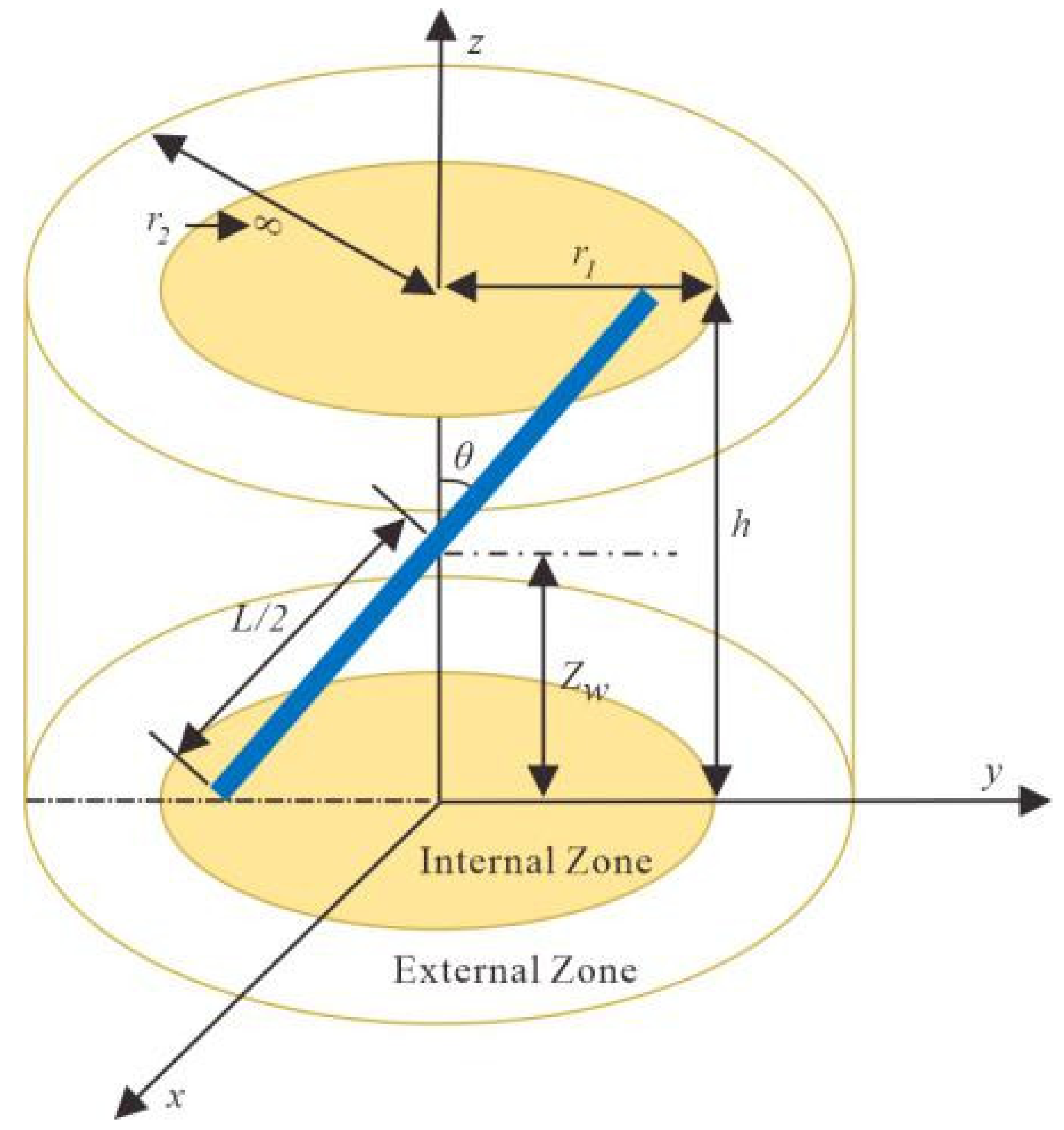



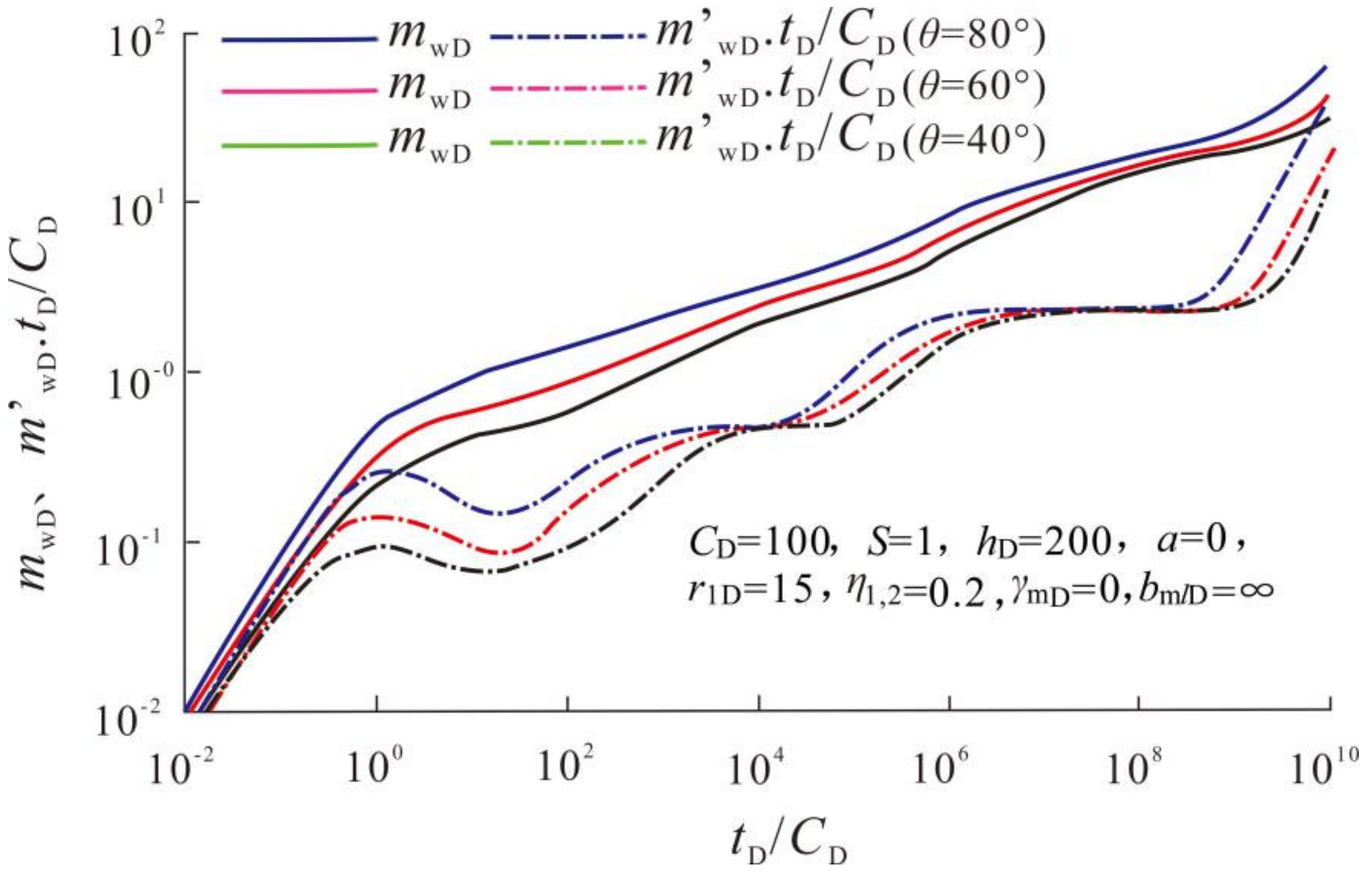
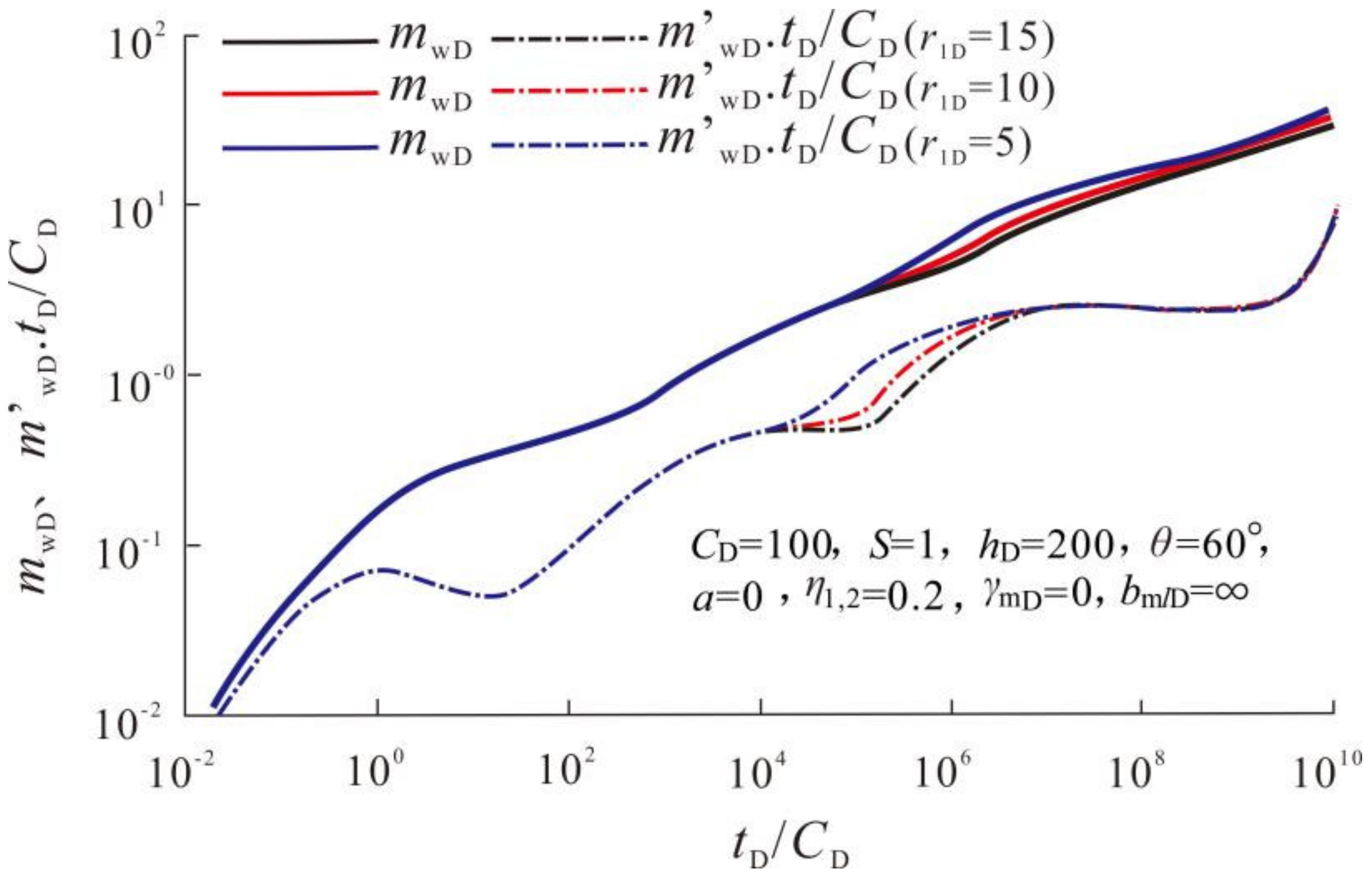
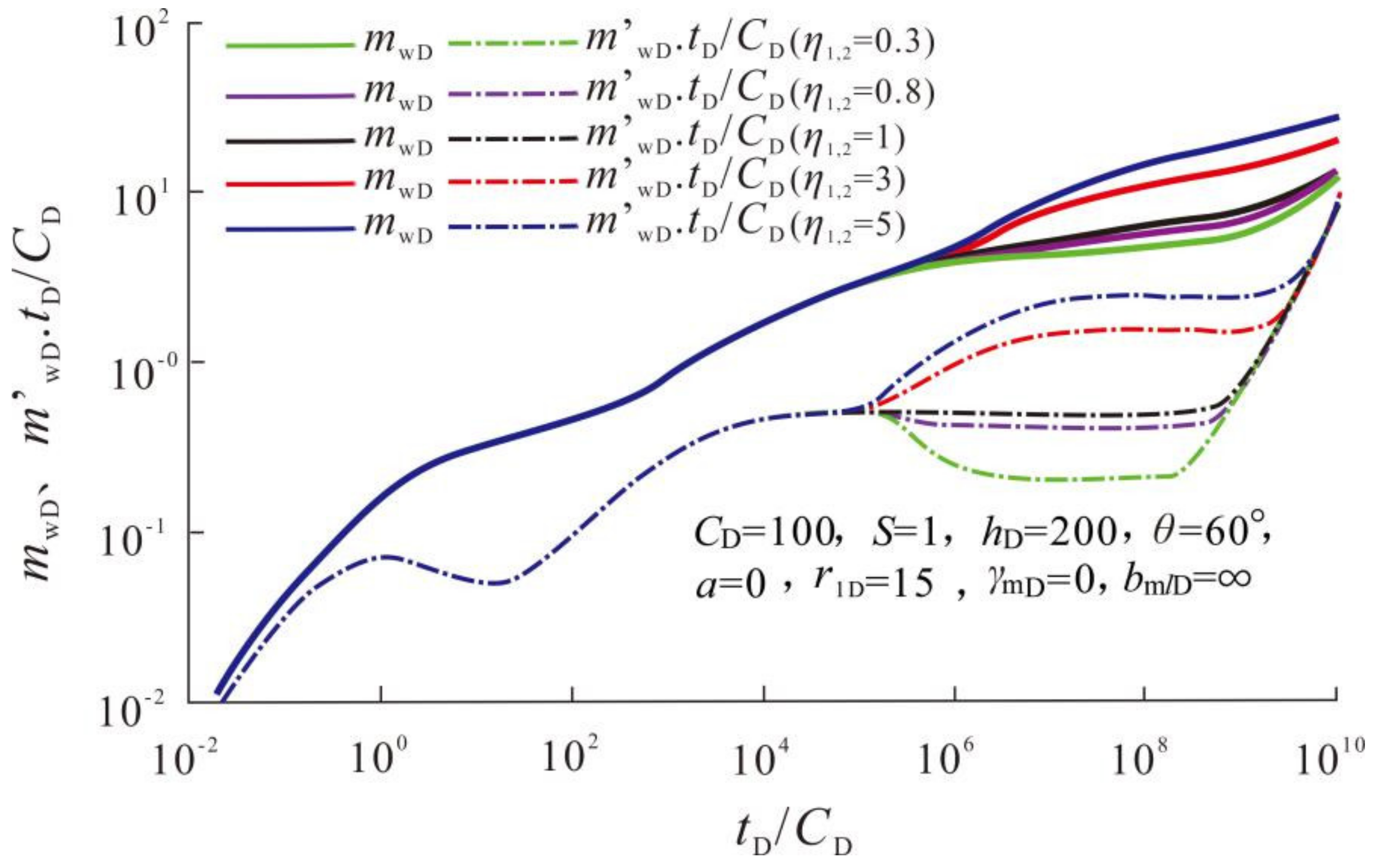
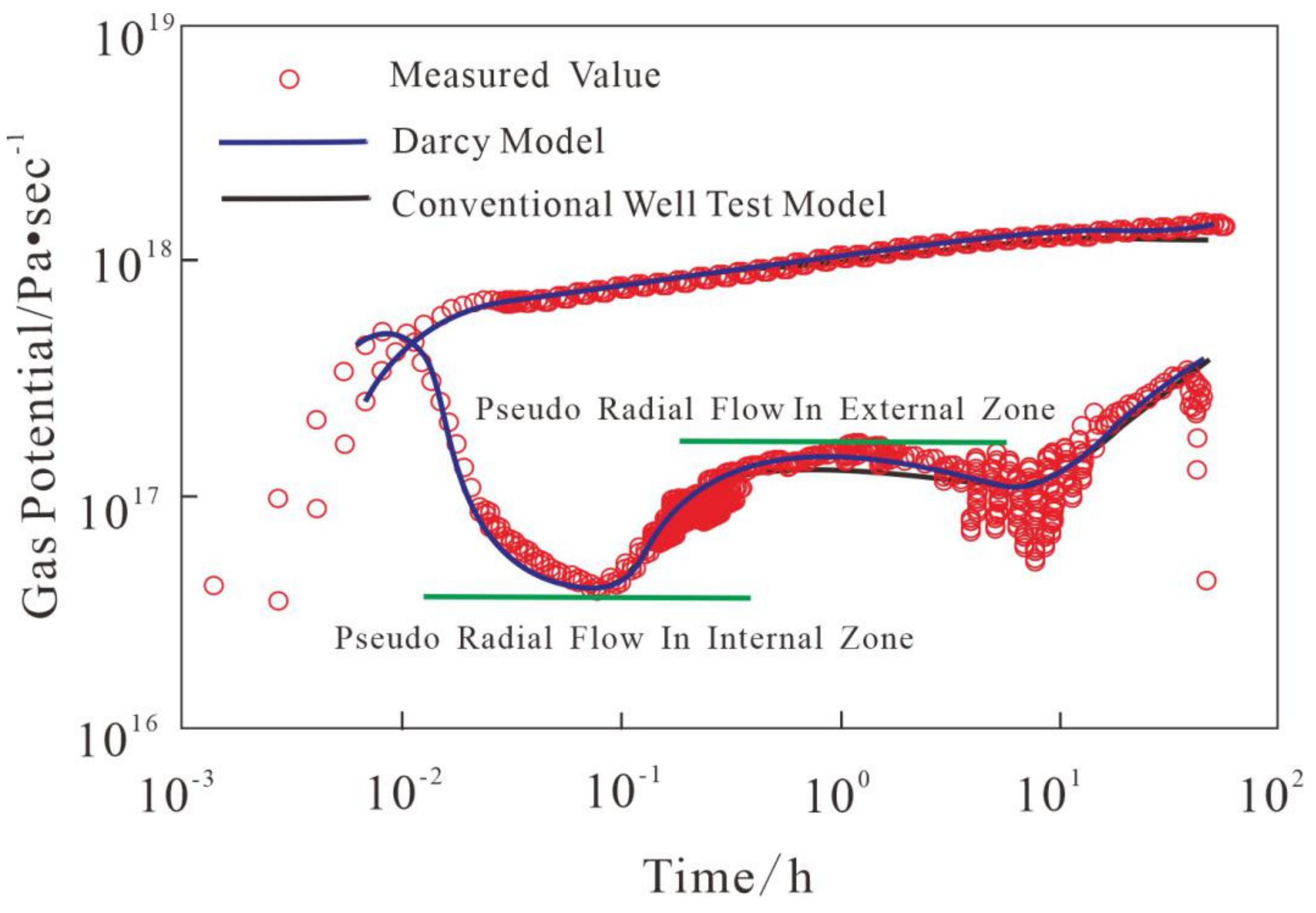

| Basic Parameters | Explain Parameters | Conventional Well Test Model | Non-Darcy Well Test Model | |
|---|---|---|---|---|
| Well radius rw/m | 0.09144 | Internal radius r1/m | 35.8 | 35.4 |
| Well angle θ/° | 30° | Skin factor S | 7.9 | 8.3 |
| Effective thickness h/m | 13.1 | Permeability of external zone k/mD | 3.2 | 5.9 |
| Porosity φ/% | 10.1 | Internal and external zone mobility ratio M1,2 | 1.70 | 1.79 |
| Reservoir temperature T/℃ | 118.44 | Wellbore storage factor C/m3·MPa−1 | 0.79 | 0.79 |
| Reservoir pressure pt/MPa | 34.58 | Initial formation pressure pi/MPa | 34.35 | 34.07 |
| Water saturation Sw/% | 20 | threshold pressure gradient b−1/MPa·m−1 | \ | 0.0032 |
| Formation compressibility factor Cf/MPa−1 | 5.29 × 10−5 | Non-linear coefficient a | \ | 0.83 |
| Ground production before testing qsc/104 m3·d−1 | 20 | Permeability modulus γ/MPa−1 | \ | 0.001 |
Publisher’s Note: MDPI stays neutral with regard to jurisdictional claims in published maps and institutional affiliations. |
© 2022 by the authors. Licensee MDPI, Basel, Switzerland. This article is an open access article distributed under the terms and conditions of the Creative Commons Attribution (CC BY) license (https://creativecommons.org/licenses/by/4.0/).
Share and Cite
Li, H.; Zhang, Q.; Wei, K.; Zeng, Y.; Zhu, Y. Well Test Analysis of Inclined Wells in the Low-Permeability Composite Gas Reservoir Considering the Non-Darcy Flow. Energies 2022, 15, 1654. https://doi.org/10.3390/en15051654
Li H, Zhang Q, Wei K, Zeng Y, Zhu Y. Well Test Analysis of Inclined Wells in the Low-Permeability Composite Gas Reservoir Considering the Non-Darcy Flow. Energies. 2022; 15(5):1654. https://doi.org/10.3390/en15051654
Chicago/Turabian StyleLi, Haoyuan, Qi Zhang, Keying Wei, Yuan Zeng, and Yushuang Zhu. 2022. "Well Test Analysis of Inclined Wells in the Low-Permeability Composite Gas Reservoir Considering the Non-Darcy Flow" Energies 15, no. 5: 1654. https://doi.org/10.3390/en15051654





